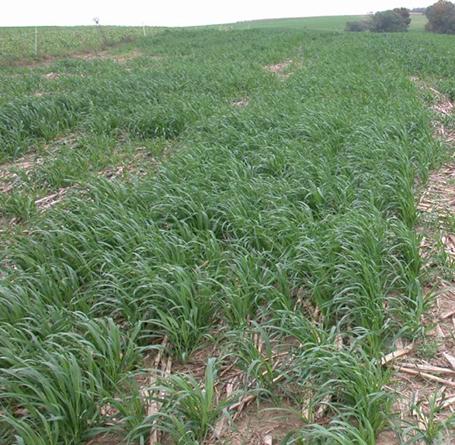Forage of the Month: Spring Oats
 When grass is in short supply during the fall and extra grazing sources are needed, spring oats can be used for grazing cattle during late fall. Oats is a high quality forage comparable to winter wheat and can be used for pasture, hay, or silage.
When grass is in short supply during the fall and extra grazing sources are needed, spring oats can be used for grazing cattle during late fall. Oats is a high quality forage comparable to winter wheat and can be used for pasture, hay, or silage.
Spring oats can be planted in early August to mid-September, often after corn silage has been harvested if it was an early crop. The planting rate for oats is about 3 bushels per acre, and it is ideal to plant into a well prepared seedbed. Oats can be planted into crop residue if weeds are killed ahead of planting. They do not establish well when broadcast seeded. When seeding oats, the producer should apply around 40 pounds of nitrogen, unless the previous crop was heavily fertilized.
With good soil moisture, spring oats will be ready to graze about 6 to 8 weeks after emergence. When grazing oats, calves and yearlings can gain over two pounds per day.
A downside to grazing oats is the potential for grass tetany. A producer should ask their veterinarian about feeding high-mag mineral while grazing oats. Also, if cattle have been grazing short or dry pastures and are suddenly turned onto a pasture of oats they can develop respiratory problems.
If choosing to use oats for hay, a producer should cut before a killing frost if plants are in a desirable growth stage. Oats cut before a killing frost can accumulate nitrates, so be sure to test this hay before feeding. After a killing frost occurs, oats should be cut soon after the plants begin to dry out.
Since spring oats will not survive the winter, they are a great choice when needing fall pasture, but you are looking to plant something different the next spring. If you have enough pasture in the fall, the good thing about spring oats is they can also be seeded in February to early March and used as a ground cover or companion crop.
Other small grain options for grazing are available, but oats can provide a high quality forage in a short period of time. For more information about spring oats, see your county extension agent or visit the Master Grazer site.
Categories:
Winter
Species/Varieties


